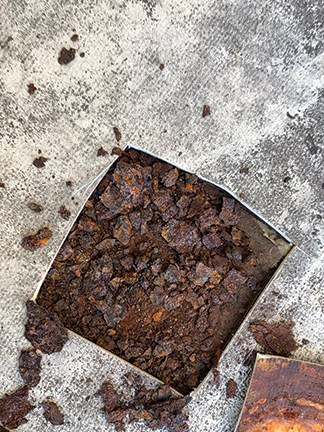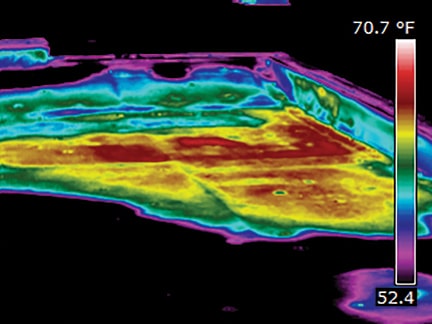By Jason Moore
From the February 2022 Issue
The need to repair a building’s roof is a situation that is all too familiar to many facility owners and managers. Still, undertaking such a large capital project like a roof repair can be hard to navigate. While costs may vary between recovering a roof or replacing a roof, it is important to know the proper questions to ask contractors in order to maximize cost savings and ensure the success of your roof repair project.

Is This Roof A Candidate For A Roof Recovering?
Recovering a roof with a single-ply membrane has become increasingly popular as organizations look to save money and limit disruptions to employees and customers. It’s critical that a knowledgeable roofing professional properly inspects the roof to ensure it is a candidate for a roof recovering, including providing a detailed explanation on the required conditions for the roof’s warranty to not be voided. Otherwise, a roof recovery project can turn into a costly headache, sometimes even forcing the facility to need to replace the roof regardless.
In most cases, when a single-ply roof recovery fails, it is because due diligence was not taken to ensure every requirement is met. As a first step in the process, a qualified roofing professional must thoroughly assess the roof’s condition, including conducting an infrared moisture survey to see if any water has seeped below the membrane.

Building codes on roof repairs prohibit recovering a saturated roof. Both the International Building Code (IBC 2012, Section 1510.3) and the Florida Building Code (Section 1511.3) state that a roof recovering cannot occur “where the existing roof or roof covering is water-soaked or has deteriorated to the point that the existing roof or roof covering is not adequate as a base for additional roofing.” Similarly, the 4th Edition Manual of Low Slope Roofs says, “Recovering carries a roughly 50% or greater risk of roof problems than constructing a new (or replacement) system.”
In my experience, I have seen firsthand the impact of a roof recovery that is conducted when the conditions did not meet building standards. In one instance, a PVC single-ply roof was mechanically fastened and attached to an existing steel deck. Unfortunately, because the roof was not properly assessed the contractor was unaware that the underlying roof had substantial moisture intrusion. The undiagnosed moisture weakened the roof’s steel fasteners and plates, causing them to oxidize and erode. This significantly hindered their ability to withstand the potential 150 MPH winds the building could face during a hurricane. If a proper roof inspection had been conducted, the moisture would have been realized, thus eliminating roof recovery as an option. Ultimately, this would have reduced the risk of further damage and resulted in cost savings overall.
An Improper Roof Recovery Can Void Roof Warranty
In addition to potential cost savings compared to a roof replacement, a major selling point by many contractors is the warranty that comes with the roof. However, if the roof recovery is improperly done, that sense of security for the facility owner or manager is actually a mirage.

While it is true that roof manufacturers do provide warranties to protect a customer in the event of unfortunate mishaps, manufacturers expect certain conditions be met prior to a project taking place. Unless a proper inspection is conducted to ensure no issues like moisture are present and that a recovery is a viable option, the roof repair could be considered improperly installed. This may shorten or even void the roof’s warranty—ultimately leaving you in jeopardy of being financially obligated for all future repairs.
Tips To Select the Right Contractor And Project
The contractor selected is vital when undertaking an important capital project, like repairing a roof. While it is important to feel comfortable with the contractor you choose to work with, it is also a must to verify that the contractor is qualified and understands local building codes. Too often, facility owners and managers do not know the questions to ask a contractor to ensure all proper steps were taken before hiring them for a job.

To prevent your roofing project from costing you more over the long run, following are several questions to ask potential contractors to ensure you are selecting the right roof repair option:
- Has a complete roof inspection, including an infrared moisture survey, been conducted?
- Has any moisture seeped into the insulation or any lightweight insulating concrete?
- Has any moisture caused rusting or affected the stability of the roof?
- Does a roof recovery meet all applicable building code standards and conditions for the building?
- Will a roof recovery project affect my roof’s slope or ability to properly drain moisture?
- Does a roof recovery meet all of the manufacturer’s conditions or does it risk the roof’s warranty, causing it to be shortened or voided?
The Bottom Line
Single-ply roof recoveries can be viable options for a facility in certain cases, as long as the proper conditions and requirements are met. While the cost savings can be appealing, a roof recovery that does not meet all the conditions puts your facility at risk of additional damage, more disruption to facility operations, and can be more costly over the long run.
Before you sign off on a contractor for a roof repair job, ensure your contractor does his or her due diligence and properly surveys the viability of each roof repair option and provides you with all the information from their findings to make sure you can make the right decision. Ultimately, this will prevent additional disruptions to your business and strain on your bottom line.
 Moore is a senior field advisor at Tremco Roofing & Building Maintenance, a distributor of commercial roofing and building envelope, general contracting, and service solutions that maximize building performance to reduce life cycle costs. With over a decade of experience in roofing and building envelope asset management, Moore services the Northeast Florida and Florida Panhandle regions.
Moore is a senior field advisor at Tremco Roofing & Building Maintenance, a distributor of commercial roofing and building envelope, general contracting, and service solutions that maximize building performance to reduce life cycle costs. With over a decade of experience in roofing and building envelope asset management, Moore services the Northeast Florida and Florida Panhandle regions.
Do you have a comment? Share your thoughts in the Comments section below, or send an e-mail to the Editor at acosgrove@groupc.com.















![[VIDEO] Collect Asset Data at the Speed of Walking a Building](https://facilityexecutive.com/wp-content/uploads/2024/02/maxresdefault-324x160.jpg)